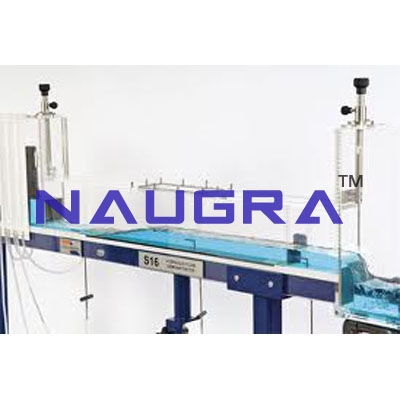- Civil Lab Mechanical Lab Engineering Lab Equipments
- sales@didacticlabequipments.com

CAT NO: DIDACTICNLE-Export-205088
EXERCISES AND PRACTICAL POSSIBILITIES
Some Practical Possibilities of the Unit: (in function of the accessories used)
1.-Measurement of the water height and the velocity along the channel.
2.-Measurement of the flow with weirs of thin wall.
3.-Measurement of flow with changes in the channel section.
4.-Measurement of flow using Venturi flume.
5.-Control of the flow by gates.
6.-Level control using syphons.
7.-Flow on overflow dams.
8.-Flow among the pillars of a bridge.
9.-Connection of a channel to a culvert.
10.-Characterization of the hydraulic jump.
11.-Profiles of the water free surface.
12.-Investigation of flow and supercritical flow states.
13.-Measurement of water levels.
14.-Discharge processes on an underwater weir.
15.-Amount of energy in flows in open channels.
16.-Function of a syphon weir.
17.-Flow rate and drain coefficients of a syphon weir.
18.-Pipe flows.
19.-Comparison of overflow and syphon weirs.
20.-Observation of the throw of the water.
21.-Generation of different flow states by damming the down-stream water.
22.-Observation of the flow under an undershot weir:
-Observation of hydraulic motion on discharge.
23.-Relationship between dam height and discharge.
24.-Observation of discharges under a radial gate:
-Observation of hydraulic motion on discharge.
25.-Hydrostatic pressure on a weir.
26.-Investigations on waves.
27.-Behaviour of structures in rough sea.
28.-Applying and understanding Manning’s formula.
29.-Understanding sub- and super-critical flow.
30.-Learning how to apply force-momentum and steady flow energy equations to simple flow situations.
31.-Investigation of the transition from running to shooting flow.
Other possible practices:
32.-Filling of the Pitot tube.
33.-Filling of the venturi meter with analog output.
34.-Calculation of water flow.
35.-Use of level gauge for measurement of the water height. Fluid Mechanics Lab Equipments manufacturers.
